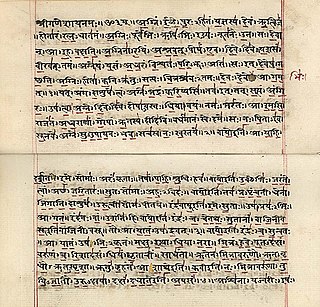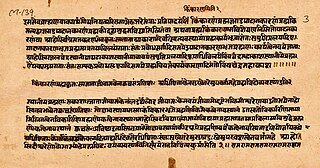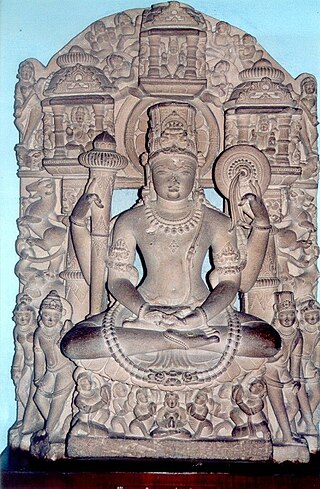
Sant Charandas was a major Hindu religious teacher in Delhi during the eighteenth century. [1]

Sant Charandas was a major Hindu religious teacher in Delhi during the eighteenth century. [1]
Caraṇdās (1703-1782) was born in Ḍahrā, near Alwar, but at the age of seven he was brought to Dehli after the death of his father. Caraṇdās claimed his guru was Śukdev, the mythological narrator of the Bhāgavata Purāṇa . He founded the Caraṇdāsī Vaiṣṇav sect in 1753. [2]
Charandas is the author of around twenty works. [3] Many of these are in verse and deal with aspects of devotion, particularly relating to the worship of Krishna. [4] He is credited by his followers with a vision of Krishna while on pilgrimage to Vraj in mid-life, as well as a further meeting with Shukdev at the same time. [1]
He wrote commentaries on various Upanishads, particularly the Katha Upanishad, [4] and on specific yoga practices, especially Pranayama, control of the breath. [5]
A member of the Sant mystical tradition, [6] Charandas's teachings draw on a wide range of sources and emphasize the nearness of the Divine to each person, the need to follow a guru, the importance of sharing in a community of like-minded believers not dependent on caste (Satsang), and the value of leading a strictly moral life.
Two of his major disciples, Sahjo Bai and Daya Bai, both women, are also famous for their poetry. [7] [8] [9]

The Bhakti movement was a significant religious movement in medieval Hinduism that sought to bring religious reforms to all strata of society by adopting the method of devotion to achieve salvation. Originating in Tamilakam during 6th century CE, it gained prominence through the poems and teachings of the Vaishnava Alvars and Shaiva Nayanars before spreading northwards. It swept over east and north India from the 15th century onwards, reaching its zenith between the 15th and 17th century CE.

Rajneesh, also known as Acharya Rajneesh, Bhagwan Shree Rajneesh, and later as Osho, was an Indian godman, philosopher, mystic, and founder of the Rajneesh movement. He was viewed as a controversial new religious movement leader during his life. He rejected institutional religions, insisting that spiritual experience could not be organized into any one system of religious dogma. As a guru, he advocated meditation and taught a unique form called dynamic meditation. Rejecting traditional ascetic practices, he advocated that his followers live fully in the world but without attachment to it. In expressing a more progressive attitude to sexuality he caused controversy in India during the late 1960s and became known as "the sex guru".

Om is a symbol representing a sacred sound, syllable, mantra, and an invocation in Hinduism. Its written representation is the most important symbol of Hinduism. It is the essence of the supreme Absolute, consciousness, Ātman,Brahman, or the cosmic world. In Indic traditions, Om serves as a sonic representation of the divine, a standard of Vedic authority and a central aspect of soteriological doctrines and practices. The syllable is often found at the beginning and the end of chapters in the Vedas, the Upanishads, and other Hindu texts.
Samkhya or Sankhya is a dualistic orthodox school of Hindu philosophy. It views reality as composed of two independent principles, Puruṣa and Prakṛti.
Brahmacharya is a concept within Indian religions that literally means "conduct consistent with Brahman" or "on the path of Brahman". In Yoga, Hinduism it generally refers to a lifestyle characterized by sexual continence or complete abstinence.
Soham or Sohum is a Hindu mantra, meaning "I am He/She/That" in Sanskrit.
In Sanskrit texts, Rāja yoga was both the goal of yoga and a method to attain it. The term also became a modern name for the practice of yoga in the 19th-century when Swami Vivekananda gave his interpretation of the Yoga Sutras of Patanjali in his book Raja Yoga. Since then, Rāja yoga has variously been called aṣṭāṅga yoga, royal yoga, royal union, sahaja marg, and classical yoga.

Dattatreya, Dattā or Dattaguru, is a paradigmatic Sannyasi (monk) and one of the lords of yoga, venerated as a Hindu god. He is considered to be an avatar and combined form of the three Hindu gods Brahma, Vishnu, and Shiva, who are also collectively known as the Trimurti, and as the manifestation of Parabrahma, the supreme being, in texts such as the Bhagavata Purana, the Markandeya Purana, and the Brahmanda Purana, though stories about his birth and origin vary from text to text. Several Upanishads are dedicated to him, as are texts of the Vedanta-Yoga tradition in Hinduism. One of the most important texts of Hinduism, namely Avadhuta Gita is attributed to Dattatreya. Over time, Dattatreya has inspired many monastic movements in Shaivism, Vaishnavism, and Shaktism, particularly in the Deccan region of India, Maharashtra, Gujarat, Madhya Pradesh, Rajasthan and Himalayan regions where Shaivism is prevalent. His pursuit of simple life, kindness to all, sharing of his knowledge and the meaning of life during his travels is reverentially mentioned in the poems by Tukaram, a saint-poet of the Bhakti movement.

Sant Tukaram Maharaj, also known as Tuka, Tukobaraya, Tukoba, was a Hindu, Marathi Saint of "Varkari sampradaya" in Dehu village, Maharashtra in the 17th century. He was a bhakt of Lord Pandurang of Pandharpur. He is best known for his devotional poetry called Abhanga, which are popular in Maharashtra, many of his poems deals with social reform.

Satyananda Saraswati, was a Sanyasi, yoga teacher and guru in both his native India and the West. He was a student of Sivananda Saraswati, the founder of the Divine Life Society, and founded the Bihar School of Yoga in 1964. He wrote over 80 books, including the popular 1969 manual Asana Pranayama Mudra Bandha.

Satya is a Sanskrit word loosely translated as truth or essence. It also refers to a virtue in Indian religions, referring to being truthful in one's thoughts, speech and action. In Yoga, satya is one of five yamas, the virtuous restraint from falsehood and distortion of reality in one's expressions and actions.
Saccidānanda is an epithet and description for the subjective experience of the ultimate unchanging reality, called Brahman, in certain branches of Hindu philosophy, especially Vedanta. It represents "existence, consciousness, and bliss" or "truth, consciousness, bliss".

The Shvetashvatara Upanishad is an ancient Sanskrit text embedded in the Yajurveda. It is listed as number 14 in the Muktika canon of 108 Upanishads. The Upanishad contains 113 mantras or verses in six chapters.

Dhyāna in Hinduism means contemplation and meditation. Dhyana is taken up in Yoga practices, and is a means to samadhi and self-knowledge.
Krishna Prakesh Bahadur (1924–2000) was an Indian writer from Allahabad, India who authored a large number of books, including many works of history, philosophy and poetry.
Harry Aveling is an Australian scholar, translator and teacher. He specialises in Indonesian and Malaysian literature, and Translation Studies. He received the degrees of Doctor of Philosophy in Malay Studies from the National University of Singapore and Doctor of Creative Arts (DCA) from the University of Technology, Sydney. Besides his academic writing, he has translated extensively from Indonesian and Malay, from Vietnamese Francophone literature, and also co-translated from Hindi. He has been awarded the Anugerah Pengembangan Sastra for his translation work. Aveling has two sons, a daughter and five granddaughters.

The Brahmavidya Upanishad is a Sanskrit text and one of the minor Upanishads of Hinduism. It is one of twenty Yoga Upanishads in the four Vedas.
Yoga philosophy is one of the six major orthodox schools of Hindu philosophy, though it is only at the end of the first millennium CE that Yoga is mentioned as a separate school of thought in Indian texts, distinct from Samkhya. Ancient, medieval and most modern literature often refers to Yoga-philosophy simply as Yoga. A systematic collection of ideas of Yoga is found in the Yoga Sutras of Patanjali, a key text of Yoga which has influenced all other schools of Indian philosophy.

The Mahavakya Upanishad is a Sanskrit text and one of the minor Upanishads of Hinduism. It is attached to the Atharvaveda, and is classified as one of the 20 Yoga Upanishads. The text describes the nature of Atman and Brahman, then asserts that they are identical and liberation is the state of fully understanding this identity.

The Mandala-brahmana Upanishad, also known as Mandalabrahmanopanisad, is one of the minor Upanishads of Hinduism and a Sanskrit text. It is attached to the Shukla Yajurveda and is classified as one of the 20 Yoga Upanishads.